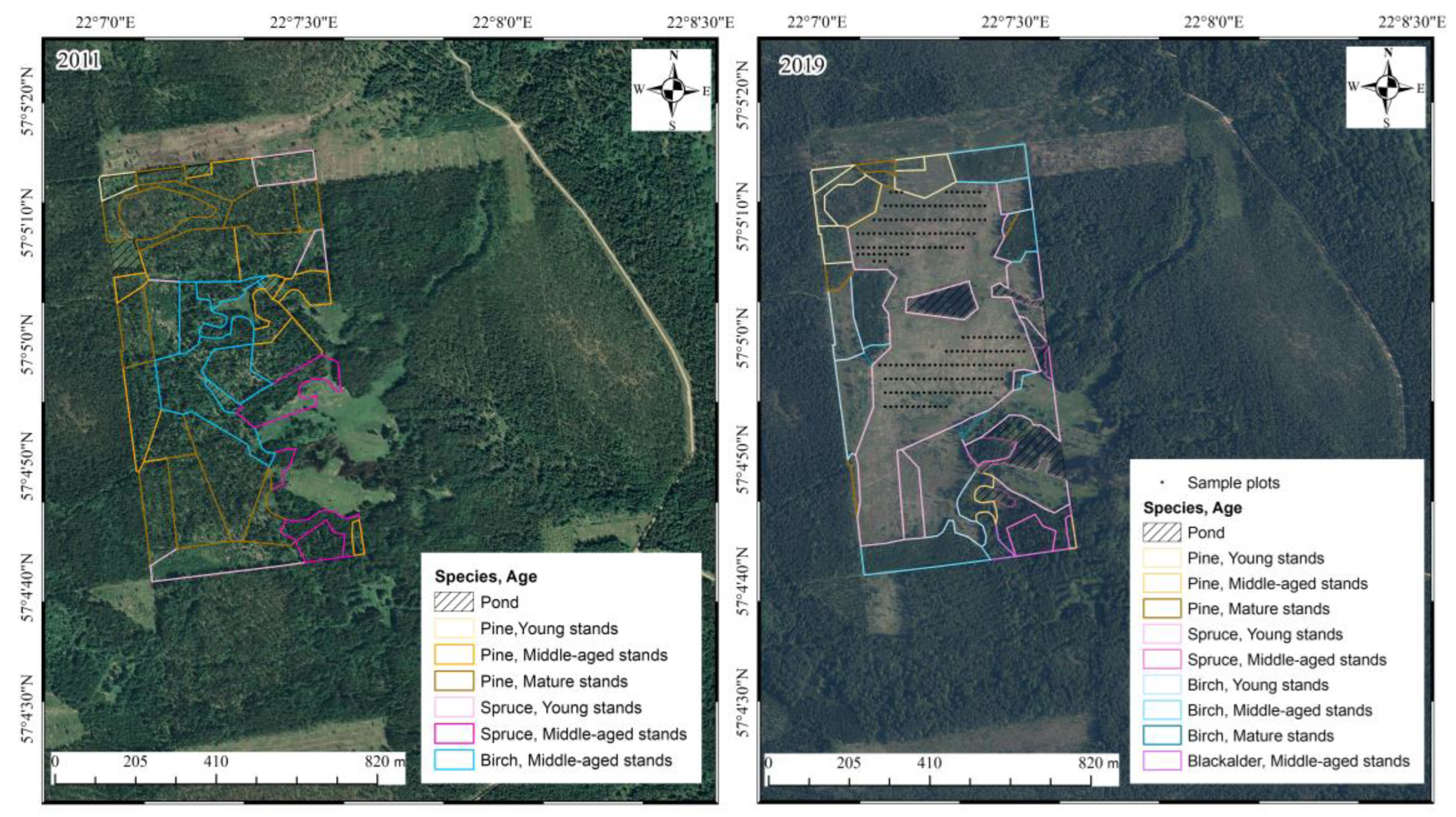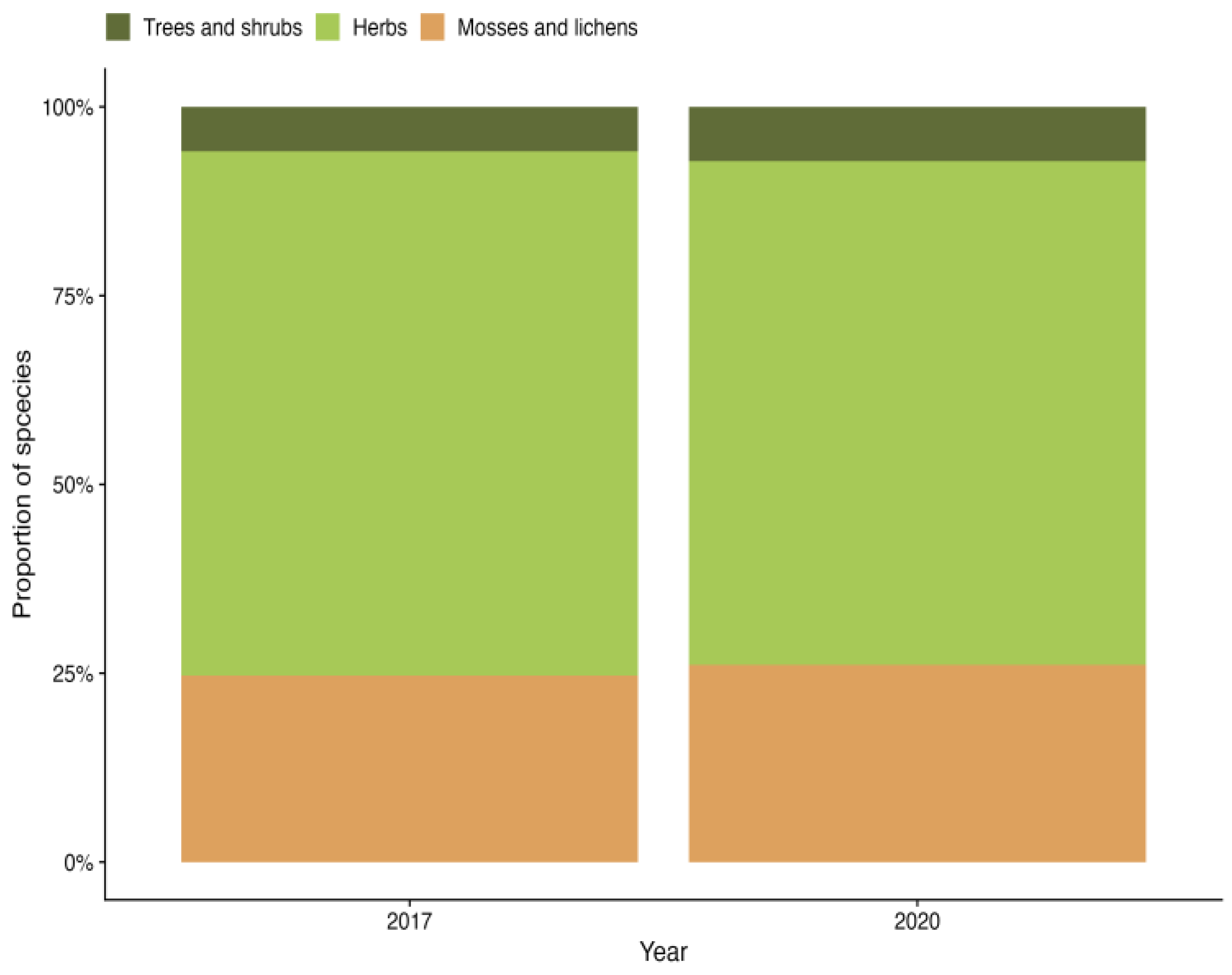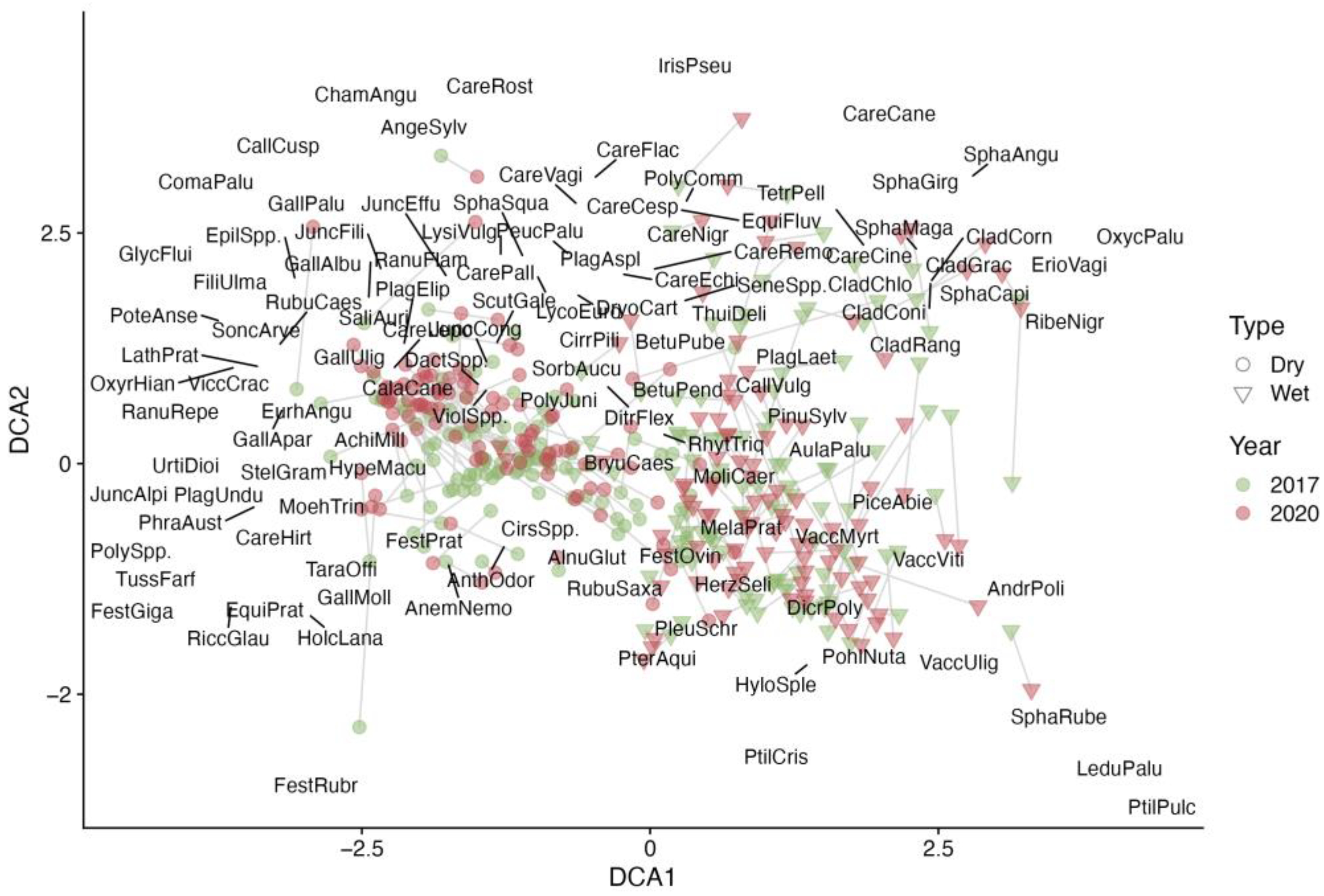Vegetation Species Diversity and Dominance After Large-Scale Clear-Cutting: Case Study from Latvia
Abstract
:1. Introduction
2. Materials and Methods
2.1. Study Area
2.2. Sampling and Measurements
2.3. Data Analysis
3. Results and Discussion
4. Conclusions
Author Contributions
Funding
Data Availability Statement
Acknowledgments
Conflicts of Interest
References
- Ahti, T.; Hämet-Ahti, L.; Jalas, J. Vegetation Zones and Their Sections in Northwestern Europe. Ann. Bot. Fenn. 1968, 5, 169–211. [Google Scholar]
- Ministry of Agriculture. Forest Sector in Numbers and Facts 2023; Zemkopības Ministrija: Rīga, Latvia, 2023; 54p. (In Latvian)
- Boucher, Y.; Auger, I.; Arseneault, D.; Elzein, T.; Sirois, L. Long-Term (1925–2015) Forest Structure Reorganization in an Actively Managed Temperate-Boreal Forest Region of Eastern North America. For. Ecol. Manag. 2021, 481, 118744. [Google Scholar] [CrossRef]
- Dieler, J.; Uhl, E.; Biber, P. Effect of Forest Stand Management on Species Composition, Structural Diversity, and Productivity in the Temperate Zone of Europe. For. Ecol. Manag. 2017, 391, 364–374. [Google Scholar] [CrossRef]
- Česonienė, L.; Daubaras, R.; Tamutis, V.; Kaškonienė, V.; Kaškonas, P.; Stakėnas, V.; Zych, M. Effect of Clear-Cutting on the Understory Vegetation, Soil and Diversity of Litter Beetles in Scots Pine-Dominated Forest. J. Sustain. For. 2019, 38, 791–808. [Google Scholar] [CrossRef]
- Meža likums 2000 (The Forest Law of the Republic of Latvia 2000). Available online: http://www.likumi.lv/doc.php?id=2825 (accessed on 27 February 2025). (In Latvian).
- Gilliam, F.S. The Ecological Significance of the Herbaceous Layer in Temperate Forest Ecosystems. Bioscience 2007, 57, 845–858. [Google Scholar] [CrossRef]
- Angelstam, K.P. Maintaining and Restoring Biodiversity in European Boreal Forests by Developing Natural Disturbance Regimes. J. Veg. Sci. 1998, 9, 593–602. [Google Scholar]
- Peterson, C.J.; Pickett, S.T.A. Forest Reorganization: A Case Study in an Old-Growth Forest Catastrophic Blowdown. Ecology 1995, 76, 763–774. [Google Scholar] [CrossRef]
- Esseen, A.P.; Ehnström, B.; Ericson, L.; Sjöberg, K. Boreal Forests. Ecol. Bull. 2015, 46, 16–47. [Google Scholar]
- Franklin, J.F.; Lindenmayer, D.; Macmahon, J.A.; Mckee, A.; Perry, D.A.; Waide, R.; Foster, D. Threads of Continuity: Ecosystem Disturbance, Recovery, and the Theory of Biological Legacies. Conserv. Pract. 2000, 1, 8–17. [Google Scholar] [CrossRef]
- Dobrowolska, D. Forest Regeneration in Northeastern Poland Following a Catastrophic Blowdown. Can. J. For. Res. 2015, 45, 1172–1182. [Google Scholar] [CrossRef]
- Tonteri, T.; Salemaa, M.; Rautio, P.; Hallikainen, V.; Korpela, L.; Merilä, P. Forest Management Regulates Temporal Change in the Cover of Boreal Plant Species. For. Ecol. Manag. 2016, 381, 115–124. [Google Scholar] [CrossRef]
- Hannerz, M.; Hånell, B. Effects on the flora in Norway spruce forests following clearcutting and shelterwood cutting. For. Ecol. Manag. 1997, 90, 29–49. [Google Scholar] [CrossRef]
- 15Prévost, M.; Raymond, P. Effect of Gap Size, Aspect and Slope on Available Light and Soil Temperature after Patch-Selection Cutting in Yellow Birch-Conifer Stands, Quebec, Canada. For. Ecol. Manag. 2012, 274, 210–221. [Google Scholar] [CrossRef]
- Schelker, J.; Kuglerová, L.; Eklöf, K.; Bishop, K.; Laudon, H. Hydrological Effects of Clear-Cutting in a Boreal Forest—Snowpack Dynamics, Snowmelt and Streamflow Responses. J. Hydrol. 2013, 484, 105–114. [Google Scholar] [CrossRef]
- Hannerz, M.; Hånell, B. Changes in the Vascular Plant Vegetation after Different Cutting Regimes on a Productive Peatland Site in Central Sweden. Scand. J. For. Res. 2008, 23, 37–41. [Google Scholar] [CrossRef]
- Walker, L.R.; del Moral, R. PrimarySuccession. In eLS; John Wiley & Sons, Ltd.: Chichester, UK, 2011. [Google Scholar] [CrossRef]
- Bergstedt, J.; Hagner, M.; Milberg, P. Effects on Vegetation Composition of a Modified Forest Harvesting and Propagation Method Compared with Clear-Cutting, Scarification, and Planting. Appl. Veg. Sci. 2008, 11, 159–168. [Google Scholar] [CrossRef]
- Nelson, C.R.; Halpern, C.B. Short-Term Effects of Timber Harvest and Forest Edges on Ground-Layer Mosses and Liverworts. Can. J. Bot. 2005, 83, 610–620. [Google Scholar] [CrossRef]
- Gustienė, D.; Varnagirytė-Kabašinskienė, I.; Stakėnas, V. Ground Vegetation, Forest Floor and Mineral Topsoil in a Clear-Cutting and Reforested Scots Pine Stands of Different Ages: A Case Study. J. For. Res. 2022, 33, 1247–1257. [Google Scholar] [CrossRef]
- Hylander, K. No Increase in Colonization Rate of Boreal Bryophytes Near Propagule Sources. Ecology 2009, 90, 160–169. [Google Scholar] [CrossRef]
- Karazija, S. Age-Related Dynamics of Pine Forest Communities In Lithuania. Balt. For. 2002, 9, 50–62. [Google Scholar]
- Pykälä, J. Immediate Increase in Plant Species Richness after Clear-Cutting of Boreal Herb-Rich Forests. Appl. Veg. Sci. 2004, 7, 29–34. [Google Scholar] [CrossRef]
- AS Latvijas Valsts Meži. Handbook for Forest Type Identification; Latvijas Valsts meži: Rīga, Latvia, 2013; pp. 1–67. (In Latvian) [Google Scholar]
- Kottek, M.; Grieser, J.; Beck, C.; Rudolf, B.; Rubel, F. World Map of the Köppen-Geiger Climate Classification Updated. Meteorol. Z. 2006, 15, 259–263. [Google Scholar] [CrossRef]
- Harris, I.; Osborn, T.J.; Jones, P.; Lister, D. Version 4 of the CRU TS Monthly High-Resolution Gridded Multivariate Climate Dataset. Sci. Data 2020, 7, 1–18. [Google Scholar] [CrossRef]
- Shannon, C.E. A mathematical theory of communications. Bell. Syst. Tech. J. 1948, 27, 379–423. [Google Scholar] [CrossRef]
- Pielou, E.C. Ecological Diversity. Limnol. Oceanogr. 1975, 22, 165. [Google Scholar] [CrossRef]
- Oksanen, J.; Blanchet, F.G.; Kindt, R.; Legendre, P.; Minchin, P.R.; O’Hara, R.B.; Simpson, G.L.; Solymos, P.; Stevens, M.H.H.; Wagner, H. Package ‘Vegan’, Version 2.0-5. Community Ecol. Package 2013, 2, 1–295. [Google Scholar]
- Correa-Metrio, A.; Garcia, S.L.; Caballero, M. Detrended Correspondence Analysis: A Useful Tool to Quantify Ecological Changes from Fossil Data Sets. Bol. Soc. Geol. Mex. 2014, 66, 135–143. [Google Scholar] [CrossRef]
- R Core Team. R: A Language and Environment for Statistical Computing; R Foundation for Statistical Computing: Vienna, Austria, 2024; Available online: https://www.R-project.org/ (accessed on 20 December 2024).
- Marozas, V. Early Succession of Ground Vegetation After Clear-Cuttings in Spruce Forests in a Boreonemoral Zone, Lithuania. Acta Biol. Univ. Daugavp. 2005, 5, 127–136. [Google Scholar]
- Tefańska-Krzaczek, E.S.; Staniaszek-Kik, M. Positive Aspects of Clear-Cut Logging? Ground Bryophyte Diversity along the Age Gradient of Managed Pinus Sylvestris Stands. Cryptogam. Bryol. 2016, 37, 181–197. [Google Scholar] [CrossRef]
- Heinrichs, S.; Schmidt, W. Short-Term Effects of Selection and Clear Cutting on the Shrub and Herb Layer Vegetation during the Conversion of Even-Aged Norway Spruce Stands into Mixed Stands. For. Ecol. Manag. 2009, 258, 667–678. [Google Scholar] [CrossRef]
- Zobel, M. Secondary Forest Succession in Jarvselja, Southern Estonia: Changes in Field Layer Vegetation. Ann. Bot. Fenn. 1989, 26, 171–182. [Google Scholar]
- Genikova, N.; Mamontov, V. Decade-Long Dynamics of the Ground Vegetation in an Ecotone between Coniferous Forest and Clear-Cut Site. Environ. Sci. Proc. 2022, 22, 15. [Google Scholar] [CrossRef]
- Palviainen, M.; Finér, L.; Mannerkoski, H.; Piirainen, S.; Starr, M. Responses of Ground Vegetation Species to Clear-Cutting in a Boreal Forest: Aboveground Biomass and Nutrient Contents during the First 7 Years. Ecol. Res. 2005, 20, 652–660. [Google Scholar] [CrossRef]
- Nykvist, N. Changes in species occurrence and phytomass after clearfelling, prescribed burning and slash removal in two Swedish spruce forests. Stud. For. Suec. 1997, 201, 1–33. [Google Scholar]
- Jalonen, J.; Vanha-Majamaa, I. Immediate Effects of Four Different Felling Methods on Mature Boreal Spruce Forest Understorey Vegetation in Southern Finland. For. Ecol. Manag. 2001, 146, 25–34. [Google Scholar] [CrossRef]
- Kellomäki, S.; Hari, P.; Väisänen, E. Annual Production of Some Forest Mosses as a Function of Light Available for Photosynthesis. Silva Fenn. 1977, 11, 81–86. [Google Scholar] [CrossRef]
- Janke, A. Transpiration resistance in Vaccinium Myrtillus. Amer. J. Bot. 1970, 57, 1051–1054. [Google Scholar]
- Miina, J.; Hotanen, J.; Salo, K. Modelling the Abundance and Temporal Variation in the Production of Bilberry (Vaccinium myrtillus L.) in Finnish Mineral Soil Forests. Silva Fenn. 2009, 43, 577–593. [Google Scholar] [CrossRef]
- Lõhmus, A.; Remm, L. Disentangling the Effects of Seminatural Forestry on an Ecosystem Good: Bilberry (Vaccinium myrtillus) in Estonia. For. Ecol. Manag. 2017, 404, 75–83. [Google Scholar] [CrossRef]
- Nielsen, A.; Totland, Ø.; Ohlson, M. The Effect of Forest Management Operations on Population Performance of Vaccinium myrtillus on a Landscape-Scale. Basic Appl. Ecol. 2007, 8, 231–241. [Google Scholar] [CrossRef]
- Saetre, P. Spatial Patterns of Ground Vegetation, Soil Microbial Biomass and Activity in a Mixed Spruce-Birch Stand. Ecography 1999, 22, 183–192. [Google Scholar] [CrossRef]
- Strengbom, J.; Walheim, M.; Näsholm, T.; Ericson, L. Regional Differences in the Occurrence of Understorey Species Reflect Nitrogen Deposition in Swedish Forests. Ambio 2003, 32, 91–97. [Google Scholar] [CrossRef] [PubMed]
- Mäkipää, R.; Heikkinen, J. Large-Scale Changes in Abundance of Terricolous Bryophytes and Macrolichens in Finland. J. Veg. Sci. 2003, 14, 497–508. [Google Scholar] [CrossRef]



| 2017 | 2020 | ||||
|---|---|---|---|---|---|
| Taxa Names | F | C | F | C | |
| Herbs | Deschampsia flexuosa L. | 49.5 | 19.3 | 21.0 | 15.0 |
| Trientalis europaea L. | 48.6 | 2.7 | 15.7 | 1.9 | |
| Vaccinium myrtillus L. | 42.4 | 6.4 | 28.1 | 11.0 | |
| Agrostis capillaris L. | 38.1 | 18.4 | 39.5 | 10.4 | |
| Calluna vulgaris L. | 36.2 | 5.3 | 30.5 | 15.4 | |
| Calamagrostis spp. | 34.3 | 25.1 | 40.0 | 20.0 | |
| Rubus idaeus L. | 28.1 | 7.5 | 24.3 | 4.2 | |
| Juncus conglomeratus L. | 27.6 | 4.8 | 23.8 | 6.0 | |
| Luzula pilosa L. | 22.9 | 7.7 | 21.9 | 7.8 | |
| Vaccinium vitis-idaea L. | 22.4 | 17.2 | 31.4 | 16.3 | |
| Moss | Pleurozium schreberi Brid. | 51.0 | 13.4 | 22.9 | 19.3 |
| Dicranum polysetum Sw. | 29.0 | 8.7 | 20.5 | 12.3 | |
| Hylocomium splendens Hedw. | 23.3 | 20.9 | 20.5 | 24.7 | |
Disclaimer/Publisher’s Note: The statements, opinions and data contained in all publications are solely those of the individual author(s) and contributor(s) and not of MDPI and/or the editor(s). MDPI and/or the editor(s) disclaim responsibility for any injury to people or property resulting from any ideas, methods, instructions or products referred to in the content. |
© 2025 by the authors. Licensee MDPI, Basel, Switzerland. This article is an open access article distributed under the terms and conditions of the Creative Commons Attribution (CC BY) license (https://creativecommons.org/licenses/by/4.0/).
Share and Cite
Jansone, D.; Liepiņa, A.A.; Elferts, D.; Jansons, Ā. Vegetation Species Diversity and Dominance After Large-Scale Clear-Cutting: Case Study from Latvia. Sustainability 2025, 17, 2849. https://doi.org/10.3390/su17072849
Jansone D, Liepiņa AA, Elferts D, Jansons Ā. Vegetation Species Diversity and Dominance After Large-Scale Clear-Cutting: Case Study from Latvia. Sustainability. 2025; 17(7):2849. https://doi.org/10.3390/su17072849
Chicago/Turabian StyleJansone, Diāna, Agnese Anta Liepiņa, Didzis Elferts, and Āris Jansons. 2025. "Vegetation Species Diversity and Dominance After Large-Scale Clear-Cutting: Case Study from Latvia" Sustainability 17, no. 7: 2849. https://doi.org/10.3390/su17072849
APA StyleJansone, D., Liepiņa, A. A., Elferts, D., & Jansons, Ā. (2025). Vegetation Species Diversity and Dominance After Large-Scale Clear-Cutting: Case Study from Latvia. Sustainability, 17(7), 2849. https://doi.org/10.3390/su17072849








